KIA CERATO 2008 Repair Manual
Manufacturer: KIA, Model Year: 2008, Model line: CERATO, Model: KIA CERATO 2008Pages: 327, PDF Size: 42.19 MB
Page 61 of 327
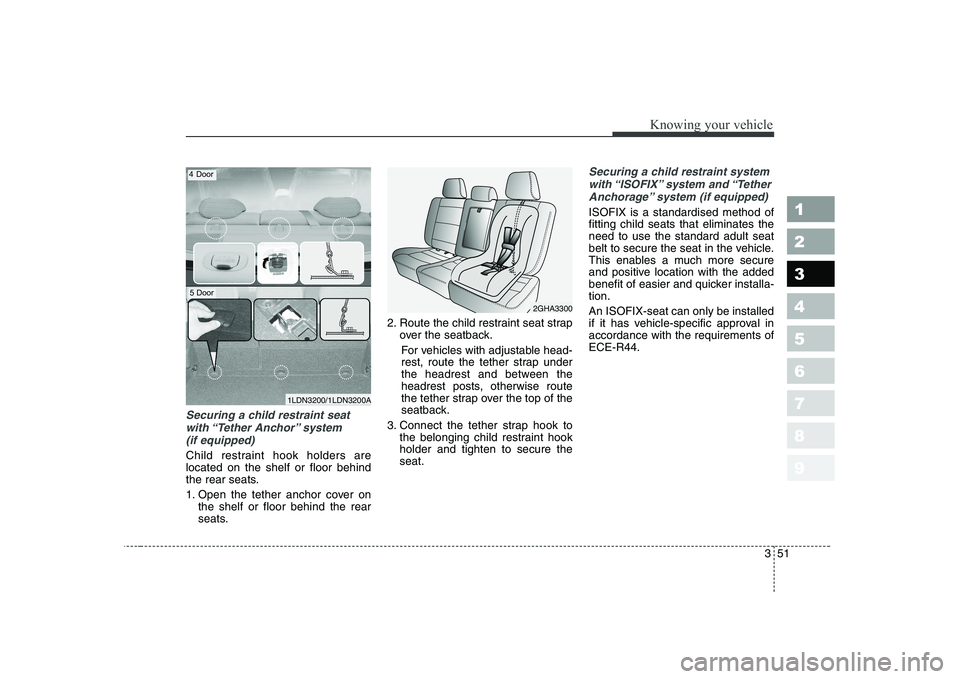
351
1 23456789
Knowing your vehicle
Securing a child restraint seatwith “Tether Anchor” system (if equipped)
Child restraint hook holders are located on the shelf or floor behind
the rear seats.
1. Open the tether anchor cover on the shelf or floor behind the rear
seats. 2. Route the child restraint seat strap
over the seatback.
For vehicles with adjustable head-
rest, route the tether strap under
the headrest and between the
headrest posts, otherwise route
the tether strap over the top of the
seatback.
3. Connect the tether strap hook to the belonging child restraint hookholder and tighten to secure theseat.
Securing a child restraint system
with “ISOFIX” system and “Tether Anchorage” system (if equipped)
ISOFIX is a standardised method of fitting child seats that eliminates theneed to use the standard adult seat
belt to secure the seat in the vehicle.
This enables a much more secure
and positive location with the added
benefit of easier and quicker installa-tion. An ISOFIX-seat can only be installed
if it has vehicle-specific approval inaccordance with the requirements ofECE-R44.
1LDN3200/1LDN3200A
2GHA3300
4 Door
5 Door
Page 62 of 327
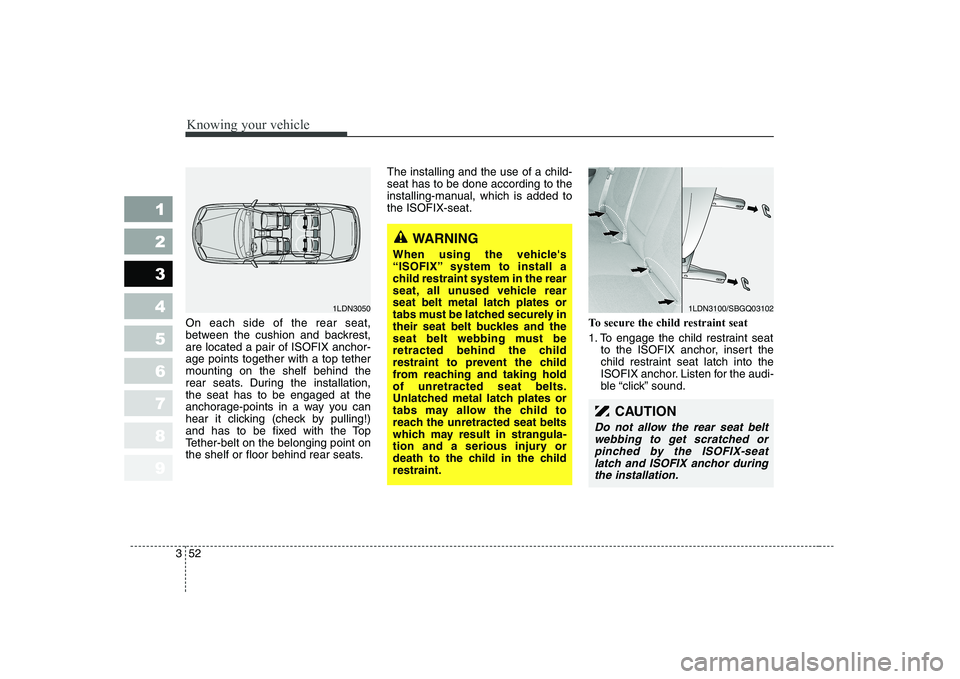
Knowing your vehicle
52
3
1 23456789
On each side of the rear seat,
between the cushion and backrest,are located a pair of ISOFIX anchor-age points together with a top tethermounting on the shelf behind the
rear seats. During the installation,the seat has to be engaged at the
anchorage-points in a way you can
hear it clicking (check by pulling!)
and has to be fixed with the Top
Tether-belt on the belonging point on
the shelf or floor behind rear seats. The installing and the use of a child-seat has to be done according to the
installing-manual, which is added tothe ISOFIX-seat.
To secure the child restraint seat
1. To engage the child restraint seatto the ISOFIX anchor, insert the
child restraint seat latch into the
ISOFIX anchor. Listen for the audi-
ble “click” sound.
1LDN3100/SBGQ03102
WARNING
When using the vehicle's
“ISOFIX” system to install a
child restraint system in the rear
seat, all unused vehicle rear
seat belt metal latch plates or
tabs must be latched securely in
their seat belt buckles and the
seat belt webbing must be
retracted behind the child
restraint to prevent the child
from reaching and taking holdof unretracted seat belts.
Unlatched metal latch plates or
tabs may allow the child to
reach the unretracted seat belts
which may result in strangula-
tion and a serious injury or
death to the child in the childrestraint.
1LDN3050
CAUTION
Do not allow the rear seat belt webbing to get scratched orpinched by the ISOFIX-seatlatch and ISOFIX anchor during the installation.
Page 63 of 327
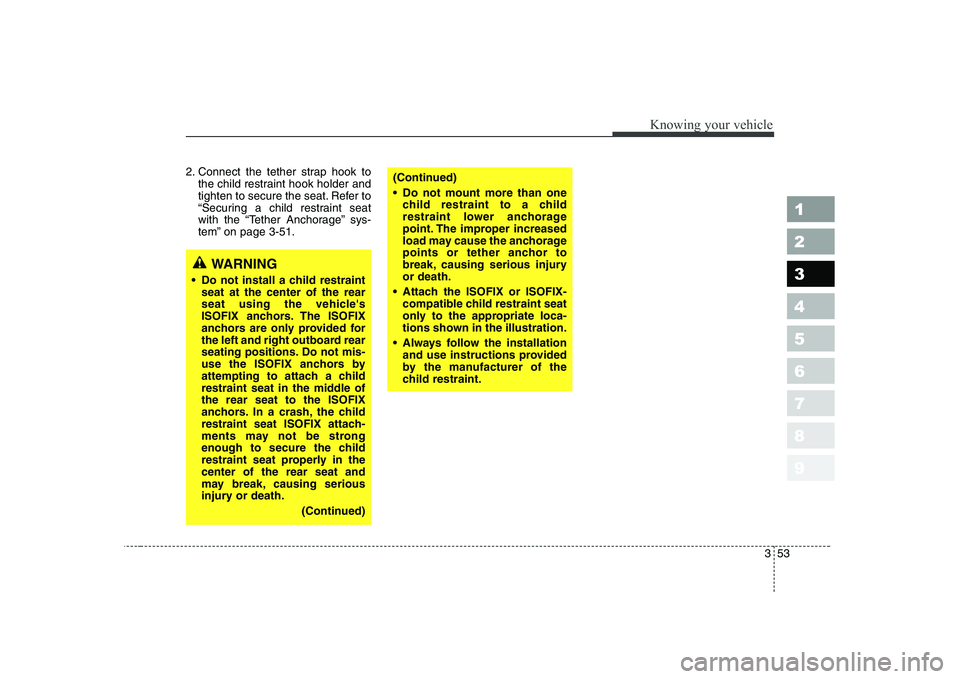
353
1 23456789
Knowing your vehicle
2. Connect the tether strap hook tothe child restraint hook holder and
tighten to secure the seat. Refer to
“Securing a child restraint seat
with the “Tether Anchorage” sys-
tem” on page 3-51.
WARNING
Do not install a child restraint seat at the center of the rear
seat using the vehicle's
ISOFIX anchors. The ISOFIX
anchors are only provided for
the left and right outboard rear
seating positions. Do not mis-
use the ISOFIX anchors by
attempting to attach a child
restraint seat in the middle ofthe rear seat to the ISOFIX
anchors. In a crash, the child
restraint seat ISOFIX attach-
ments may not be strong
enough to secure the child
restraint seat properly in thecenter of the rear seat and
may break, causing serious
injury or death.
(Continued)
(Continued)
Do not mount more than onechild restraint to a child
restraint lower anchorage
point. The improper increased
load may cause the anchorage
points or tether anchor to
break, causing serious injuryor death.
Attach the ISOFIX or ISOFIX- compatible child restraint seat
only to the appropriate loca-
tions shown in the illustration.
Always follow the installation and use instructions provided
by the manufacturer of the
child restraint.
Page 64 of 327
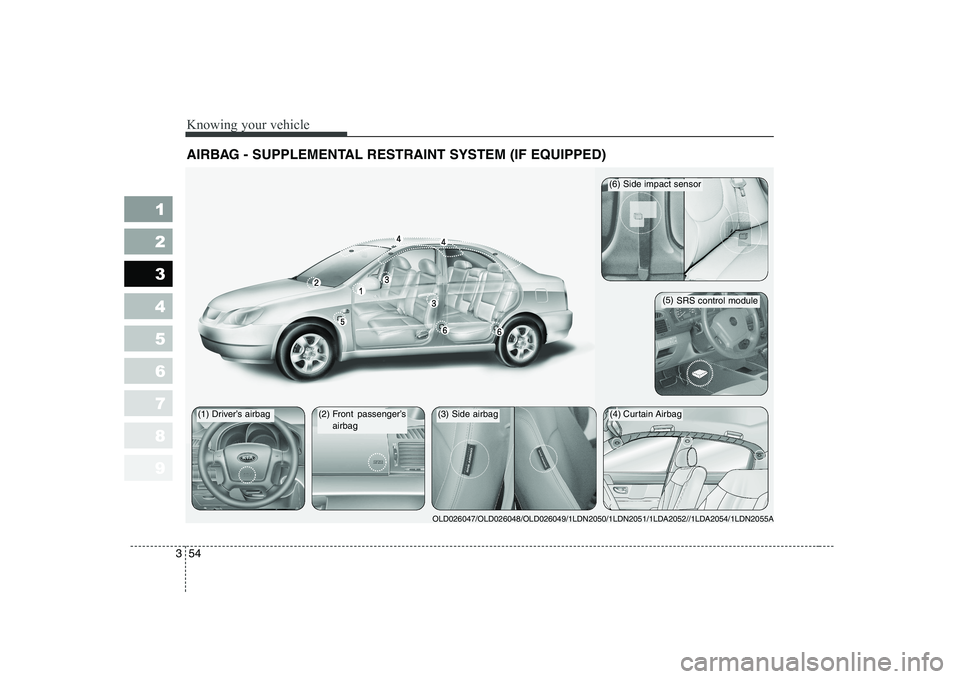
Knowing your vehicle
54
3
1 23456789
AIRBAG - SUPPLEMENTAL RESTRAINT SYSTEM (IF EQUIPPED)
(1) Driver’s airbag(2) Front passenger’s
airbag(4) Curtain Airbag
(5) SRS control module
OLD026047/OLD026048/OLD026049/1LDN2050/1LDN2051/1LDA2052//1LDA2054/1LDN2055A
(3) Side airbag
(6) Side impact sensor
Page 65 of 327
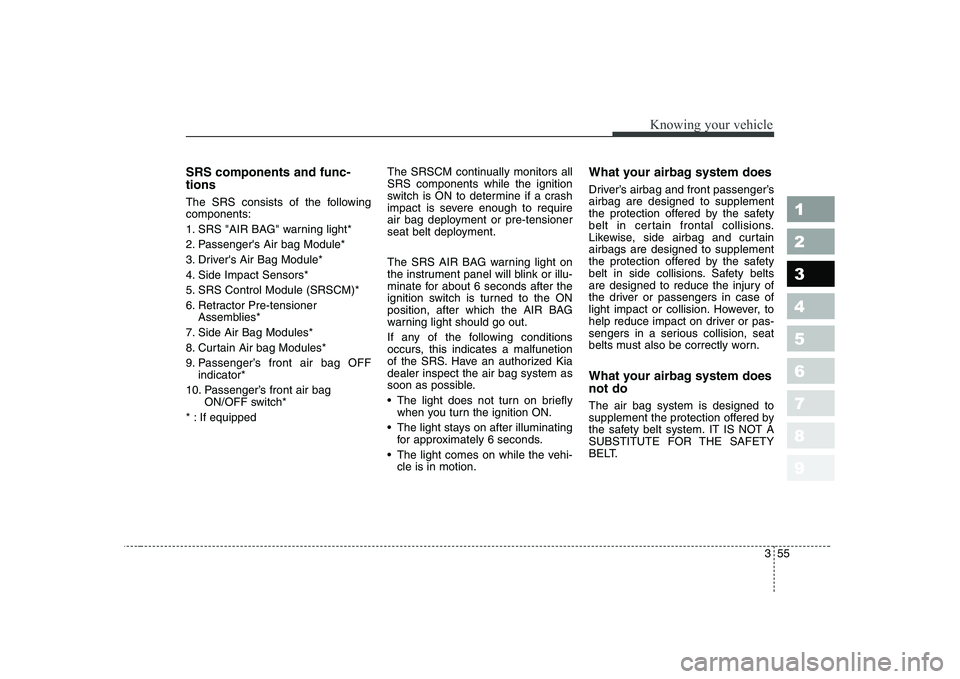
355
1 23456789
Knowing your vehicle
SRS components and func- tions
The SRS consists of the following components:
1. SRS "AIR BAG" warning light*
2. Passenger's Air bag Module*
3. Driver's Air Bag Module*
4. Side Impact Sensors*
5. SRS Control Module (SRSCM)*
6. Retractor Pre-tensionerAssemblies*
7. Side Air Bag Modules*
8. Curtain Air bag Modules*
9. Passenger’s front air bag OFF indicator*
10. Passenger’s front air bag ON/OFF switch*
* : If equipped The SRSCM continually monitors all SRS components while the ignition
switch is ON to determine if a crash
impact is severe enough to require
air bag deployment or pre-tensioner
seat belt deployment.
The SRS AIR BAG warning light on
the instrument panel will blink or illu-
minate for about 6 seconds after the
ignition switch is turned to the ON
position, after which the AIR BAG
warning light should go out.
If any of the following conditions
occurs, this indicates a malfunetion
of the SRS. Have an authorized Kiadealer inspect the air bag system as
soon as possible.
The light does not turn on briefly
when you turn the ignition ON.
The light stays on after illuminating for approximately 6 seconds.
The light comes on while the vehi- cle is in motion. What your airbag system does
Driver’s airbag and front passenger’s airbag are designed to supplement
the protection offered by the safety
belt in certain frontal collisions.
Likewise, side airbag and curtainairbags are designed to supplement
the protection offered by the safety
belt in side collisions. Safety belts
are designed to reduce the injury of
the driver or passengers in case of
light impact or collision. However, to
help reduce impact on driver or pas-
sengers in a serious collision, seat
belts must also be correctly worn.
What your airbag system does not do The air bag system is designed to
supplement the protection offered by
the safety belt system. IT IS NOT A
SUBSTITUTE FOR THE SAFETY
BELT.
Page 66 of 327
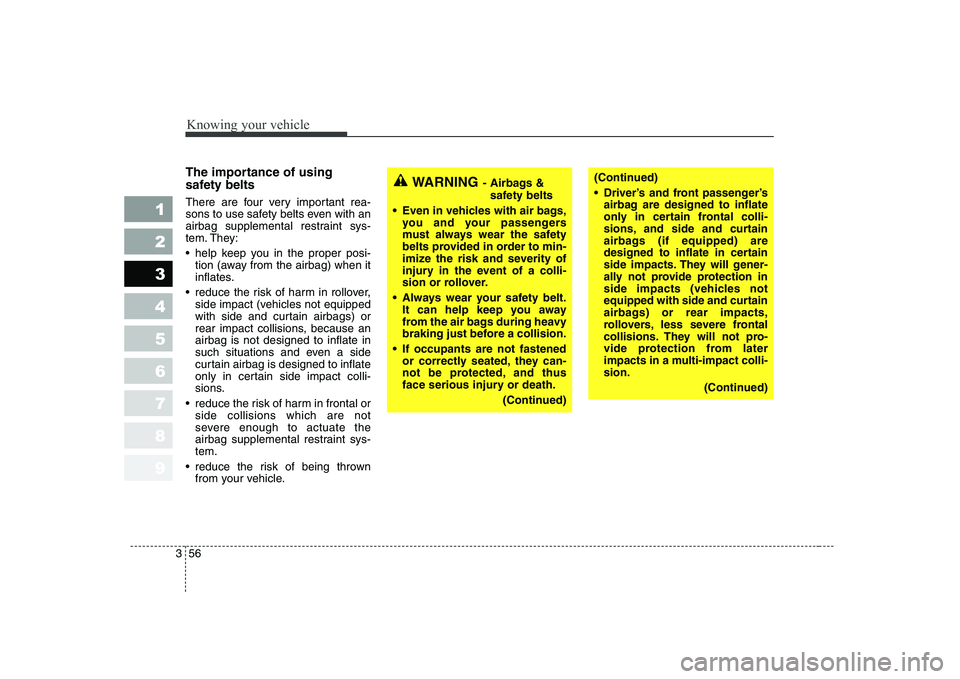
Knowing your vehicle
56
3
1 23456789
The importance of using
safety belts
There are four very important rea-
sons to use safety belts even with an
airbag supplemental restraint sys-
tem. They:
help keep you in the proper posi-
tion (away from the airbag) when it
inflates.
reduce the risk of harm in rollover, side impact (vehicles not equipped
with side and curtain airbags) or
rear impact collisions, because anairbag is not designed to inflate in
such situations and even a side
curtain airbag is designed to inflate
only in certain side impact colli-
sions.
reduce the risk of harm in frontal or side collisions which are not
severe enough to actuate the
airbag supplemental restraint sys-tem.
reduce the risk of being thrown from your vehicle.WARNING - Airbags &
safety belts
Even in vehicles with air bags, you and your passengers
must always wear the safety
belts provided in order to min-
imize the risk and severity of
injury in the event of a colli-
sion or rollover.
Always wear your safety belt. It can help keep you away
from the air bags during heavy
braking just before a collision.
If occupants are not fastened or correctly seated, they can-
not be protected, and thus
face serious injury or death.
(Continued)(Continued)
Driver’s and front passenger’sairbag are designed to inflate
only in certain frontal colli-
sions, and side and curtain
airbags (if equipped) are
designed to inflate in certain
side impacts. They will gener-
ally not provide protection in
side impacts (vehicles not
equipped with side and curtain
airbags) or rear impacts,
rollovers, less severe frontal
collisions. They will not pro-
vide protection from later
impacts in a multi-impact colli-sion.
(Continued)
Page 67 of 327
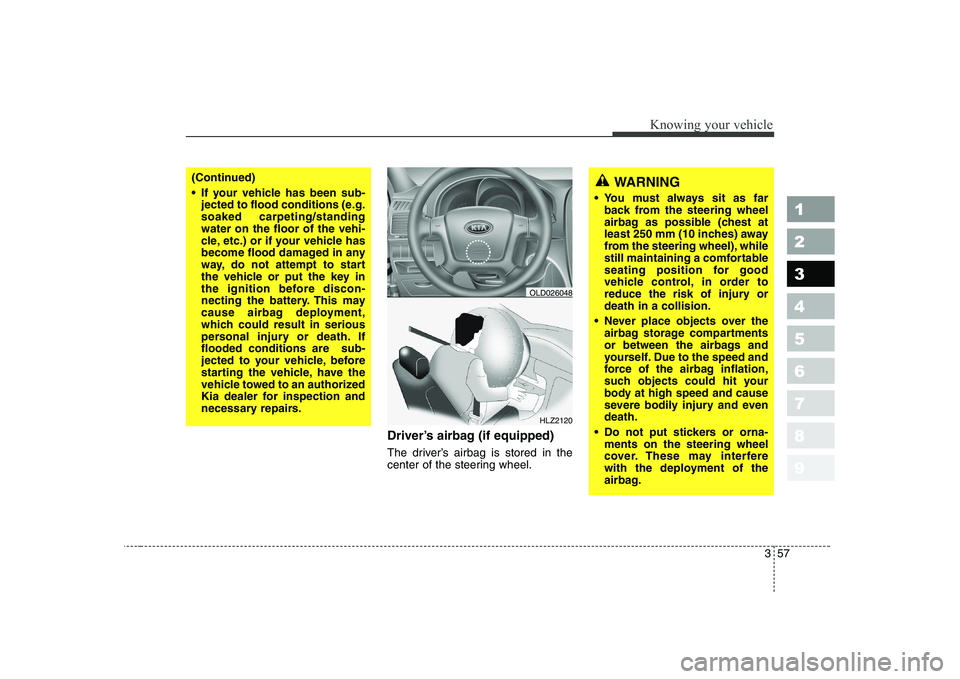
357
1 23456789
Knowing your vehicle
Driver’s airbag (if equipped)
The driver’s airbag is stored in the
center of the steering wheel.
HLZ2120
(Continued)
If your vehicle has been sub-jected to flood conditions (e.g. soaked carpeting/standingwater on the floor of the vehi-
cle, etc.) or if your vehicle has
become flood damaged in any
way, do not attempt to start
the vehicle or put the key in
the ignition before discon-
necting the battery. This may
cause airbag deployment,
which could result in serious
personal injury or death. Ifflooded conditions are sub-
jected to your vehicle, before
starting the vehicle, have the
vehicle towed to an authorized
Kia dealer for inspection and
necessary repairs.
OLD026048
WARNING
You must always sit as far back from the steering wheel
airbag as possible (chest at
least 250 mm (10 inches) away
from the steering wheel), while
still maintaining a comfortable
seating position for good
vehicle control, in order to
reduce the risk of injury ordeath in a collision.
Never place objects over the airbag storage compartments
or between the airbags and
yourself. Due to the speed and
force of the airbag inflation,
such objects could hit your
body at high speed and cause
severe bodily injury and evendeath.
Do not put stickers or orna- ments on the steering wheel
cover. These may interfere
with the deployment of the
airbag.
Page 68 of 327
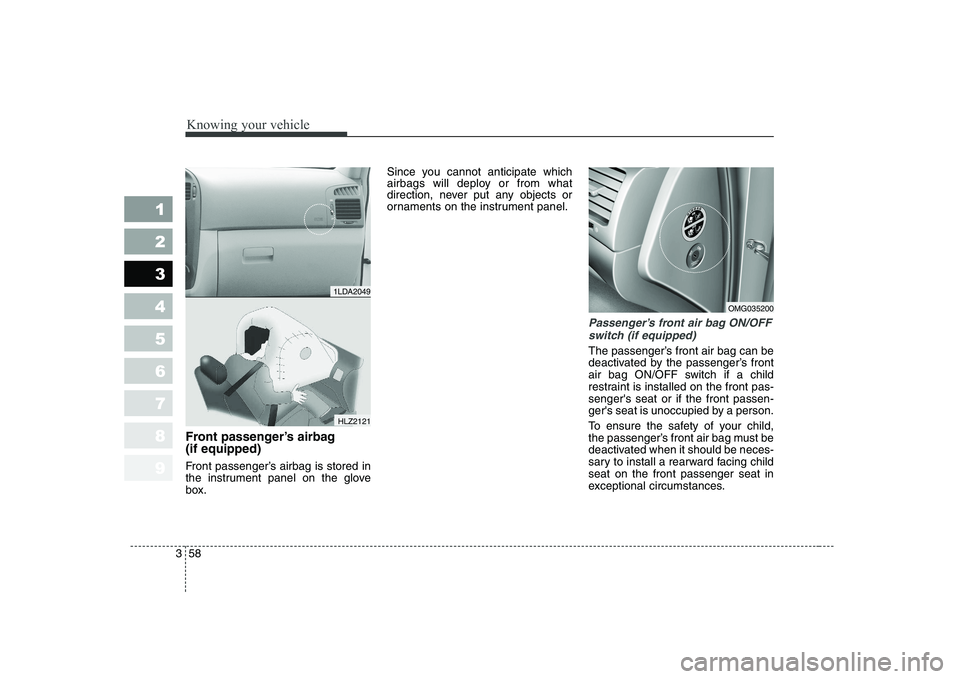
Knowing your vehicle
58
3
1 23456789
Front passenger’s airbag (if equipped)
Front passenger’s airbag is stored in
the instrument panel on the glove
box. Since you cannot anticipate which
airbags will deploy or from what
direction, never put any objects or
ornaments on the instrument panel.
Passenger’s front air bag ON/OFF
switch (if equipped)
The passenger’s front air bag can be
deactivated by the passenger’s front
air bag ON/OFF switch if a child
restraint is installed on the front pas-senger's seat or if the front passen-
ger's seat is unoccupied by a person.
To ensure the safety of your child,
the passenger’s front air bag must be
deactivated when it should be neces-
sary to install a rearward facing childseat on the front passenger seat in
exceptional circumstances.
1LDA2049
HLZ2121
OMG035200
Page 69 of 327
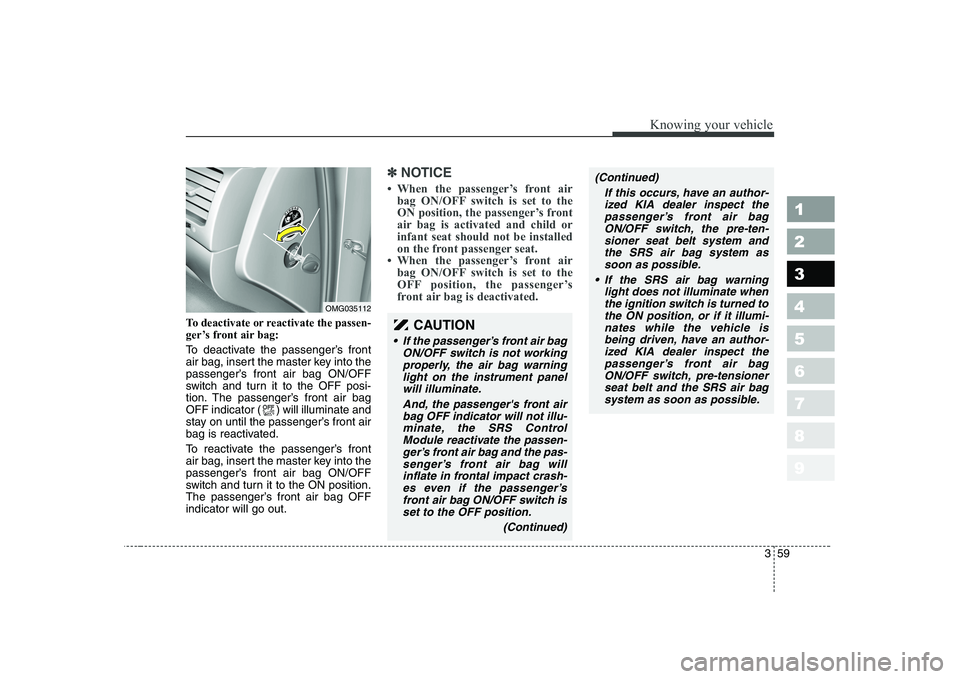
359
1 23456789
Knowing your vehicle
To deactivate or reactivate the passen-
ger’s front air bag:
To deactivate the passenger’s front
air bag, insert the master key into the
passenger’s front air bag ON/OFF
switch and turn it to the OFF posi-
tion. The passenger’s front air bag
OFF indicator ( ) will illuminate and
stay on until the passenger’s front air
bag is reactivated.
To reactivate the passenger’s front
air bag, insert the master key into the
passenger’s front air bag ON/OFF
switch and turn it to the ON position.
The passenger’s front air bag OFFindicator will go out.
✽✽NOTICE
Page 70 of 327
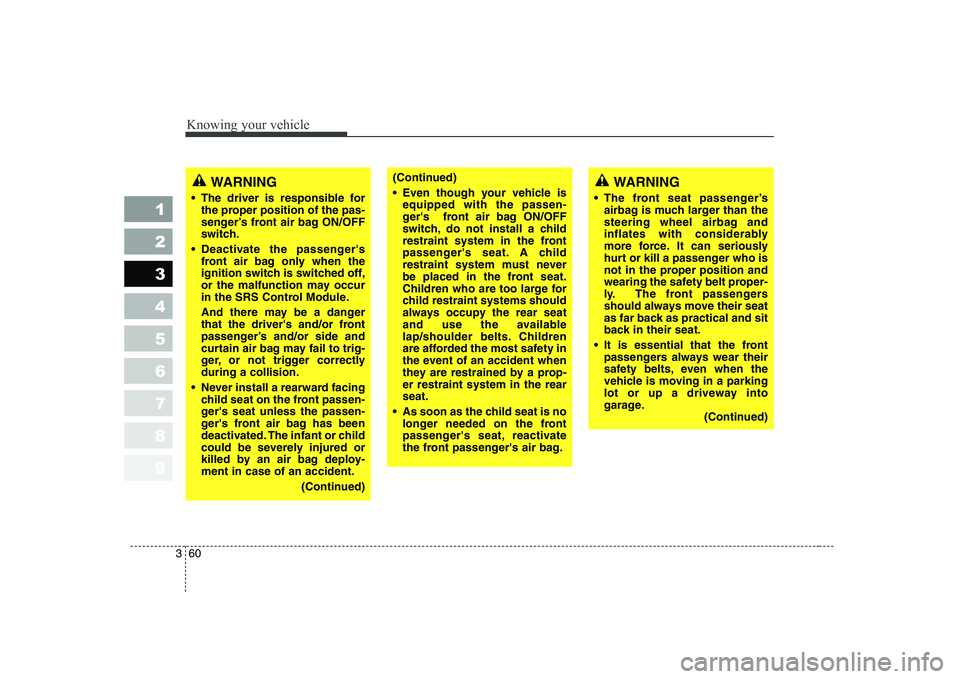
Knowing your vehicle
60
3
1 23456789
WARNING
The front seat passenger’s airbag is much larger than the
steering wheel airbag and
inflates with considerably
more force. It can seriously
hurt or kill a passenger who is
not in the proper position and
wearing the safety belt proper-
ly. The front passengers
should always move their seat
as far back as practical and sit
back in their seat.
It is essential that the front passengers always wear their
safety belts, even when the
vehicle is moving in a parking
lot or up a driveway into
garage. (Continued)WARNING
The driver is responsible for the proper position of the pas-
senger’s front air bag ON/OFF
switch.
Deactivate the passenger's front air bag only when the
ignition switch is switched off,
or the malfunction may occur
in the SRS Control Module.
And there may be a danger
that the driver's and/or front
passenger’s and/or side and
curtain air bag may fail to trig-
ger, or not trigger correctlyduring a collision.
Never install a rearward facing child seat on the front passen-
ger's seat unless the passen-
ger's front air bag has been
deactivated. The infant or child
could be severely injured or
killed by an air bag deploy-ment in case of an accident.
(Continued)(Continued)
Even though your vehicle isequipped with the passen-
ger's front air bag ON/OFF
switch, do not install a child
restraint system in the front
passenger's seat. A child
restraint system must never
be placed in the front seat.
Children who are too large for
child restraint systems should
always occupy the rear seat
and use the available
lap/shoulder belts. Children
are afforded the most safety in
the event of an accident when
they are restrained by a prop-er restraint system in the rearseat.
As soon as the child seat is no longer needed on the front
passenger's seat, reactivate
the front passenger's air bag.